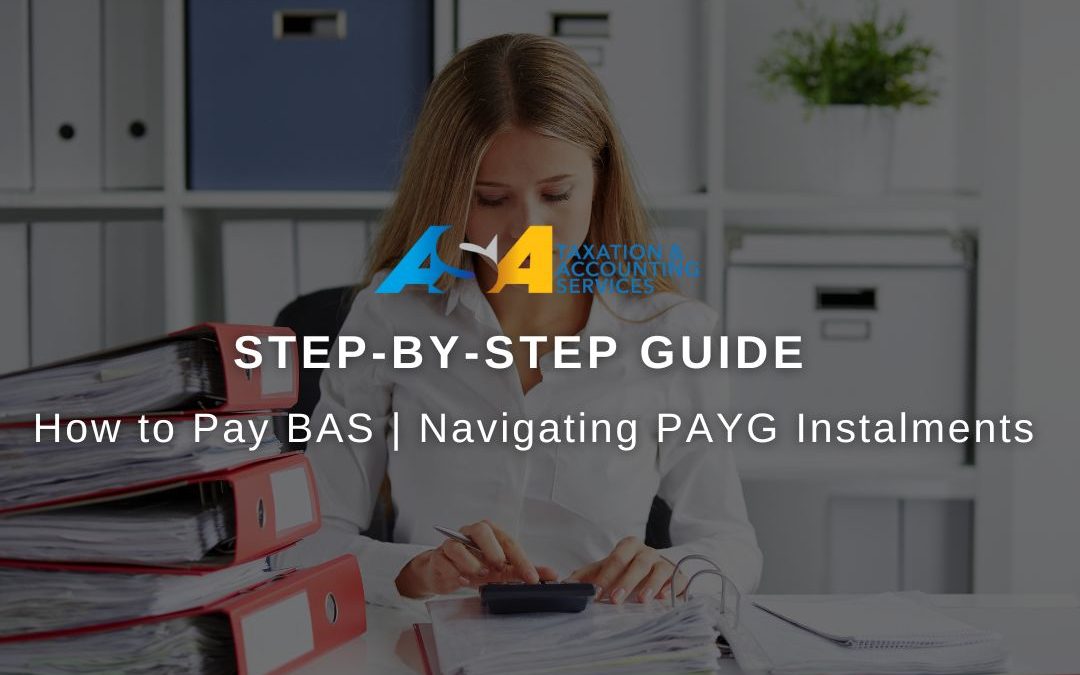Paying BAS (Business Activity Statements) and managing PAYG (Pay As You Go) instalments are essential tasks for Australian businesses. In this article, we’ll provide a step-by-step guide on how to pay BAS and navigate PAYG instalments, ensuring compliance with the Australian Taxation Office (ATO) regulations.
Understanding Business Activity Statements (BAS)
Business Activity Statements (BAS) are periodic submissions required by the ATO that summarise a business’s tax obligations. These statements help businesses report and pay their Pay As You Go (PAYG) instalments, Goods and Services Tax (GST), PAYG withholding and other tax obligations.
Components of BAS
- GST Management: Reporting and paying the GST collected on sales minus the GST paid on purchases.
- PAYG Withholding: Reporting amounts withheld from payments to employees.
- PAYG Instalments: Prepaying tax on your business and investment income.
- Other taxes: Reporting any other tax obligations like Fringe Benefits Tax (FBT) or luxury car tax.
How to Pay BAS
Step 1: Gather Your Information
Before lodging your BAS, collect all relevant financial information, including sales and purchase records, employee salaries and any other income or expenses. Accurate record-keeping is crucial for correcting BAS lodgements.
Step 2: Complete Your BAS Form
Log in to the ATO’s Business Portal or use your accounting software to fill out the BAS form. Contact a reputable tax consultant to ensure all sections, such as GST management, PAYG withholding and PAYG instalments, are accurately completed.
Step 3: Review and Submit
Double-check all entries for accuracy. Once satisfied, submit your BAS through the ATO’s Business Portal, your tax agent, or your business services accountant.
Step 4: Make Your Payment
After submitting your BAS, pay the amount owed to the ATO. Payments can be easily made via direct debit, credit card, BPAY, or Australia Post.
Step 5: Keep Records
Maintain records of your BAS lodgement and payment for at least five years. This includes keeping copies of submitted BAS forms and payment receipts.
BAS Payment Due Dates
BAS payment due dates vary depending on your business’s reporting frequency (monthly, quarterly, or annually). Generally, the due dates are:
- Monthly: 21st of the following month
- Quarterly: 28th of the month following the end of the quarter (28th October, 28th February, 28th April and 28th July)
- Annually: Varies; typically aligned with the annual tax return deadline
Navigating PAYG Instalments
PAYG instalments allow businesses to pay small amounts of their expected tax liability throughout the year rather than paying a huge sum at the end. This helps manage cash flow and avoid large tax debts.
Step 1: Check Eligibility and Registration
The ATO will ideally notify you if you need to start PAYG instalments. You can also voluntarily enter the system if it suits your business needs. Register for PAYG instalments through the ATO’s Business Portal or consult with your business tax advisor.
Step 2: Calculate Instalments
PAYG instalments are calculated based on your business’s expected income. The ATO provides an instalment rate or amount which you can use to calculate your quarterly payments.
Step 3: Pay Instalments
Pay your instalments by the due dates provided by the ATO. For convenience, these are usually aligned with BAS payment due dates.
Step 4: Adjust Instalments
If your business income fluctuates, you can adjust your PAYG instalment amounts to match your expected income better. This can be done through the ATO’s Business Portal.
Step 5: Annual Reconciliation
At the end of the financial year, reconcile your PAYG instalments against your actual tax liability. Any and all overpayments can be refunded or applied to future tax liabilities.
Benefits of Proper BAS and PAYG Management
- Compliance: Ensures your business complies with tax laws and avoids penalties.
- Cash Flow Management: This method spreads tax payments throughout the year, improving cash flow.
- Accuracy: Helps maintain accurate financial records for better business decisions.
- Stress Reduction: Reduces the stress of a large tax bill at the end of the year.
Common Mistakes to Avoid
- Late Lodgement: Missing BAS lodgement deadlines can result in fines.
- Incorrect Information: Providing inaccurate information can lead to penalties and increased scrutiny from the ATO.
- Ignoring PAYG Instalments: Failing to pay PAYG instalments can accumulate a significant tax debt.
- Poor Record-Keeping: Inadequate records can lead to errors in your BAS and PAYG submissions.
Tips for Effective BAS and PAYG Management
- Use Accounting Software: Automate calculations and ensure accurate data entry.
- Engage a Business Services Accountant: Professional advice can help in accurate BAS lodgement and PAYG management.
- Stay Informed: Regularly check the ATO website for updates on tax laws and payment due dates.
- Plan: Budget for your BAS payments and PAYG instalments to avoid cash flow issues.
How ASA Taxation & Accounting Services Can Help
Navigating the complexities of BAS lodgement and PAYG instalments can be challenging. ASA Taxation & Accounting Services offers comprehensive business advisory services, including business tax advisory, GST management and assistance with sole trader tax return preparation. Our expert team can ensure your compliance with tax obligations, help optimise your tax strategy and provide ongoing support for your business’s financial health.
Effectively managing and paying your BAS and PAYG instalments is crucial for maintaining your business’s financial health and compliance with ATO regulations. By following the steps outlined in this guide, you can streamline your BAS lodgement and PAYG payments, ensuring accuracy and avoiding penalties. For professional assistance, ASA Taxation & Accounting Services is here to help with all your business services accountant needs, offering expert advice and support for your tax and accounting requirements.
FAQ
Q1. How much does a BAS lodgement cost?
A1. The cost of lodging a BAS can vary depending on whether you do it yourself or use a professional service. If you lodge it yourself using the ATO’s Business Portal or accounting software, there is no direct cost other than your time. However, if you engage a business services accountant or tax agent, fees can range from $150 to $500 or more, depending on the complexity of your BAS and the services provided.
Q2. What date is BAS due in 2024?
A2. In 2024, the BAS payment due dates are:
- Monthly lodgers: 21st of each following month.
- Quarterly lodgers: 28th January, 28th April, 28th July and 28th October.
Always double-check with the ATO or your business tax advisory service for any specific dates applicable to your business.
Q3. What is a BAS payment?
A3. A BAS payment is the amount you owe to the ATO after completing your Business Activity Statement. This payment covers GST collected, PAYG withholding amounts, PAYG instalments and any other tax obligations reported on the BAS. It ensures that your business meets its tax liabilities on time.
Q4. What happens if you don’t pay BAS?
A4. Failing to pay your BAS on time can result in several consequences:
- Penalties: The ATO may impose penalties for late lodgement or payment.
- Interest Charges: General Interest Charge (GIC) may accrue on unpaid amounts.
- Debt Recovery: The ATO can take action to recover unpaid amounts, including garnishing bank accounts or initiating legal proceedings.
- Increased Scrutiny: Persistent non-compliance can lead to increased scrutiny and audits by the ATO.
Q5. Does a sole trader need to pay BAS?
A5. Yes, a sole trader needs to pay BAS if they are registered for GST. They must lodge a BAS to report and pay the GST on their sales, minus any GST credits for their business purchases. Additionally, sole traders may need to report and pay PAYG instalments and other tax obligations through their BAS. Consulting with a business services accountant can help ensure compliance and accurate reporting.


